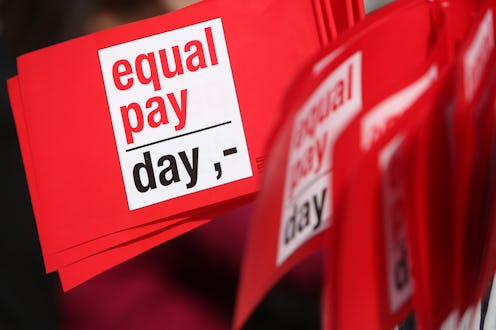News
8 Wage Gap Statistics That Prove Why We Need Equal Pay Day

The United States will be observing Equal Pay Day on April 4 this year. Every time this day arrives, droves of skeptics come out of the woodwork to let everyone know that, in reality, there is no wage gap, that it's a myth perpetuated by liberals or feminists or some other group manipulating statistics. One of the most common underlying arguments used by those attempting to dismiss that women are paid less than men is that women tend to make decisions that lead to a fate of lower paychecks.
"Using the statistic that women make 78 cents on the dollar as evidence of rampant discrimination has been debunked over and over again," wrote Karin Agness in a 2016 Forbes article. "That statistic doesn’t take into account a lot of choices that women and men make — education, years of experience and hours worked—that influence earnings."
However, it is important to recognize that not only have women's salaries been repeatedly proven to be lower in nearly every industry, but female-dominated fields are often financially valued less than male-dominated fields, regardless of whether the skills and education levels necessary for jobs in said fields are equal. Not only that, but men who pursue careers in traditionally female sectors are typically paid higher salaries than their women counterparts.
Here are just a few statistics to clear the matter up.
1. The Gap Affects Nearly Every Field
For those who think the conclusion that women earn less stems from women pursuing jobs in teaching instead of becoming hedge fund managers like men, this study by the Bureau of Labor Statistics shows that women with hundreds of different kinds of jobs nearly all, on average, earn less than men in the same fields.
2. Education Doesn't Fix The Problem
In addition to women almost always earning less than men with the same jobs, college degrees neither work to increase women's salaries as fast as they do for men, nor do they ultimately erase the gender wage gap in general, according to an analysis from the Center for American Progress.
3. More Education, Salary Still Lower
Women are now more likely to have college degrees than men, yet they still face a pay gap in every single education level, as the American Association of University Women (AAUW) noted in its study on the wage gap.
4. The Gap Persists Even In Female-Dominated Fields
Male elementary school teachers — who only make up 18.3 percent of the profession — earn a weekly average of $1,096 compared to most of their female colleagues who earn a weekly average of $956, according to the American Community Survey, which examined 3.5 million households. In other words, women who teach elementary school students typically earn 87 percent of what men doing the same earn. In nursing — a field that is 90 percent female — the gap still exists; in 2013, the median annual income for male nurses was $70,000. For female nurses the median was $60,000.
5. Even With Similar Jobs, There's Still Lower Pay
Thanks to the societal perception that "women's work" is less valuable than that of men's work, female-dominated fields have lower wages than similar ones dominated by men. As the New York Times reported, according to a study conducted by professors at Cornell University, University of Pennsylvania, and University of Haifa, janitors, for example, earn wages 22 percent higher than those of maids and housekeepers. The former are typically men, while the latter are usually women. Elementary school teachers, who largely dominate that sector of education, are paid less than secondary school teachers, where women still make up the majority, but at a much lower scale. Whereas only 10 percent of elementary school teachers are men, they make up 44 percent of secondary school educators.
6. More Women Correlates To Lower Industry-Wide Pay
When the number of female professionals starts to grow within an industry, the pay rate tends to drop. As the above-mentioned New York Times article noted of the study, "when women moved into occupations in large numbers, those jobs began paying less even after controlling for education, work experience, skills, race and geography." The pay rate for designers fell by 34 percent when women's numbers starting growing in the field, as did the salaries of biologists (dropped by 18 percent) when the same situation occurred. And this trend is not limited to just those two professions.
7. It Gets Worse When You Factor In Race
The statistic asserting that women make roughly 20 percent less than what men earn is a simplification. In reality, this number applies to white women. According to a Pew Research Center analysis of Bureau of Labor Statistics data from 2015, black women earn roughly 65 cents for every dollar a white man earns; Hispanic women have an even rougher deal, earning 58 cents to the dollar.
8. Oh, And It Gets Worse With Age, Too
While women in their twenties might be making close to what their male coworkers earn, an analysis from Visier, a workforce research firm, suggests that the gap starts to increase at around age 32. During their twenties, according to the analysis, women earn 90 percent of what their male counterparts do, but that drops to 82 percent by age 40.
With all this in mind, it's pretty hard to argue continue arguing that the gap is a myth.